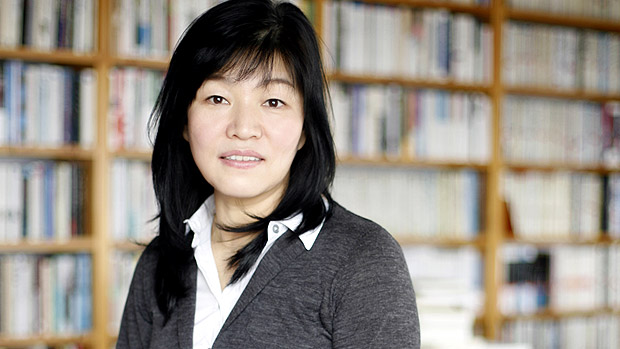The book’s narrative structure is more diegesis than conventional plot. The journeys upon which these three friends embark is more psychological than physical. Loss figures heavily in I’ll Be Right There, particularly death. Jung Yoon is haunted by her mother’s death, the professor keeps a collection of books written by people who died before the age of thirty-three – “the age at which Jesus was crucified and Alexander the Great created his empire and died” – and Miru has named her cat after Emily Dickinson whose death-themed poetry all of the characters admire. —Laura K. Warrell
I’ll Be Right There
Kyung-sook Shin
Other Press
Paperback, 336 pages, $15.95
.
The day I finished reading Kyung-sook Shin’s I’ll Be Right There, three people died in a string of shootings in Myrtle Beach, South Carolina, a mere twenty-four hours after six students were killed by a classmate at a college in Santa Barbara, California. Perhaps a root cause of the spiritual crises currently roiling in so many American bellies is the inability to contain in the same intellectual space a culture in which inexplicable violence like this occurs alongside such privilege and enlightenment. But May 2014 was hardly a peak in the horrifying human activity we call world news as much as a continuation of the kinds of events that compel us to ask why things are as they are.
The characters in I’ll Be Right There live in a different part of the world (South Korea) during a different period in history (1980s) but pose the same questions: who am I and what is this life all about? What makes Shin’s novel such a gratifying and ultimately cathartic read is the answers it provides to these monumental questions, answers that may not fit the sunny, New Age thinking of the day. As the author explains in an interview on her publisher’s website, “we may be the protagonists of tragedy [but] we are also the heroes of our most beautiful and thrilling moments.”
An acclaimed novelist in her native South Korea, Kyung-sook Shin has published seventeen works and is known for her rich explorations of the inner worlds of her characters as they attempt to navigate the constantly shifting terrain of their lives. Her previous novel, Please Look After Mom, was an international bestseller and won the Man Asian Literary prize in 2012. I’ll Be Right There, her second book to appear in English, draws on Shin’s experiences as a student in Seoul during the military dictatorship of General Chun Doo-hwan whose autocratic rule triggered pro-democracy demonstrations in the 1980s. In May 1980, at least 150 people were murdered in the Gwangju massacre, an event the author told The UK Guardian was even more harrowing to her generation than the Korean War.
The novel opens with a prologue: the narrator, Jung Yoon, receives a call from an ex-boyfriend Myungsuh telling her their beloved college professor is dying. Jung Yoon’s memories immediately coalesce around one central question the dying professor’s teachings once inspired: “What are you doing with your life?” Finding an answer to that question becomes the desire every character in the novel wants to fulfill.
After the prologue, we flashback eight years; Jung Yoon is sitting in the professor’s class, watching her new classmates Myungsuh and Miru acting “like each other’s shadow”; later, the three meet at a demonstration (Myungsuh rescues Jung Yoon after she’s knocked unconscious in the ruckus), become friends, walk around the city, talk endlessly, think about moving in together but don’t, meanwhile Jung Yoon and Myungsuh become involved only to split up when the intensity of their relationship becomes unbearable. In the second half of the book, Miru, who happens to be in love with the professor, tells the story of her sister, who killed herself after her boyfriend went missing (an interest in politics seems linked to disappearances). Miru feels responsible for her sister’s unhappy life. She takes up her sister’s quest to find the missing boyfriend, a quest that ends in her death.
In the final chapter, Jung Yoon finds the courage to face her painful past by visiting her dying professor, where her suffering and the suffering of her friends gains meaning and beauty.
The main mystery of the book (the engine of the novel) is the mystery of Miru’s sister and the way she’s tied to the pro-democracy demonstrations. Before her disappearance, she passes on to Miru an envelope filled with clues she’s collected about her boyfriend — “some men came looking for him,” she says. Taking up her sister’s search for her lost lover is Miru’s answer, her existential choice, as it were, to the novel’s central question – “What are you doing with your life?”
The book’s narrative structure is more diegesis than conventional plot. The journeys upon which these three friends embark is more psychological than physical. Loss figures heavily in I’ll Be Right There, particularly death. Jung Yoon is haunted by her mother’s death, the professor keeps a collection of books written by people who died before the age of thirty-three – “the age at which Jesus was crucified and Alexander the Great created his empire and died” – and Miru has named her cat after Emily Dickinson whose death-themed poetry all of the characters admire. Several of the people who enter the narrative will not survive to its end, which contributes both to the book’s somber mood and to the ultimately uplifting spirit of its message.
But before Shin leads her characters to enlightenment, she lingers in their anguish. After Jung Yoon and Myungsuh first meet at the demonstration, he talks to her about his own disenchantment with the circumstances of life.
“‘They can’t stand it,’” he says of the protesters. “And that’s why they form barricades, throw paving bricks, and run away only to get caught and arrested. What they can’t stand is the fact that nothing ever gets better. Nothing has changed since last year…if I hadn’t met you…I might not be able to tell the difference between this day last year and today.’”
This is the first hint at Shin’s larger premise – that love and friendship are central to human existence because they rescue us from alienation and liberate us from despair. Inherent in Myungsuh’s words is the notion that social conflict is inevitable and constant, and so protest is ultimately futile. What is fresh and vital in life comes through our connections with other people.
The demonstrations insistently interrupt the three friends’ lives; bomb blasts and the scent of tear gas infect their personal moments; they stroll through riot zones; strangers telephone them begging for news of missing friends or relatives. The endless churning of political violence is both a literal and metaphorical representation of their existential crisis.
The old professor’s philosophy sustains his students and give the book its philosophical spine. Early in the novel, he tells the story of Saint Christopher, the medieval saint who wanted to spend his life serving the strongest man in the world and finally found him when he was told in a dream to carry a child on his shoulders across a river. When he gets to the other side, the child transforms into a man and tells him, “‘It was I, Christ. When you crossed that river, you were carrying the world on your shoulders.’”
“It is your fate to brave the swollen waters,” he says. “Though the waters may rise you must not stop before the child reaches the other side. So, how do we cross this river…you must treasure yourselves and hold one another dear.”
Shin uses folk tales and anecdotes like this to convey the underlying themes of the novel. She devotes pages and pages to the many stories the characters tell each other. A key bit of folklore, told by Miru, for example, is the tale of a cat who guides the dying to a salt lake while listening to them tell the stories of their lives, a tale, in fact, that seems to reflect the structure of the novel itself.
Miru’s search for her sister’s boyfriend does not have a happy ending, and the love affair between Jung Yoon and Myungsuh fails to last — they are exes by the time he telephones Jung Yoon in the novel’s first pages. But instead of a happy ending, perhaps what Shin wants for her readers is what their professor wants for his students: a life of examination that is not overcome by despair.
“Living does not mean passing through a void of nothingness but rather through a web of relationships among beings,” the professor writes in a letter. “Insofar as everything is always changing, so our sense of hope shall never die out…until you are down to your final breath, love and fight and rage and grieve and live.”
—Laura K. Warrell
Laura K. Warrell is a freelance writer living in Boston. She teaches writing at the Berklee College of Music and the University of Massachusetts Boston and is a July, 2013, graduate of the MFA program at Vermont College of Fine Arts. She has previously published both fiction and nonfiction in Numéro Cinq.



Thanks, Laura, for sharing this review. I’m definitely going to read the book.
Laura, thanks for spreading the word about this very moving novel. I was lucky enough to hear Kyung-Sook Shin at the Korean Cultural Center here in LA. We in the US just don’t get enough literature in translation and I always wonder if that’s in part because of the limited marketing plans for authors who aren’t fluent in English. Those of you concerned with cross-cultural literary events might be interested in how the KCC handled her appearance as she read from her work in Korean. She had decided in advance which sections of the novel she would read. Audience members received printed excerpts and the text was also projected on a screen behind her. An excellent interpreter was on hand as Kyung-Sook Shin had a lot to say during the reading as well as during the Q&A afterwords. By the way, she said Korea had a tradition of poetry readings but reading from a novel was unheard of until Korean fiction authors attended the Frankfurt Book Fair and were expected to read. They thought it was a bizarre thing to do, but since it worked, they took the idea back to Korea where even now some (but fewer each day) purists find it inappropriate.
I’m chiming in late here, but thanks to you both!